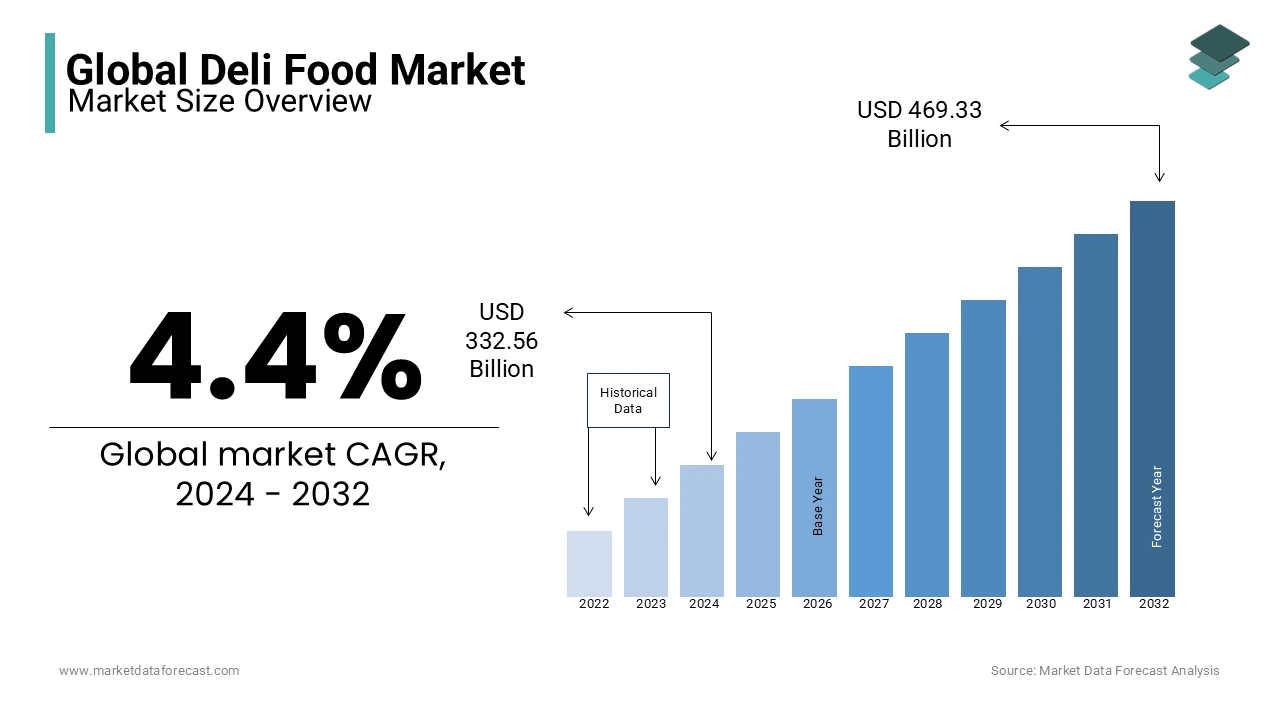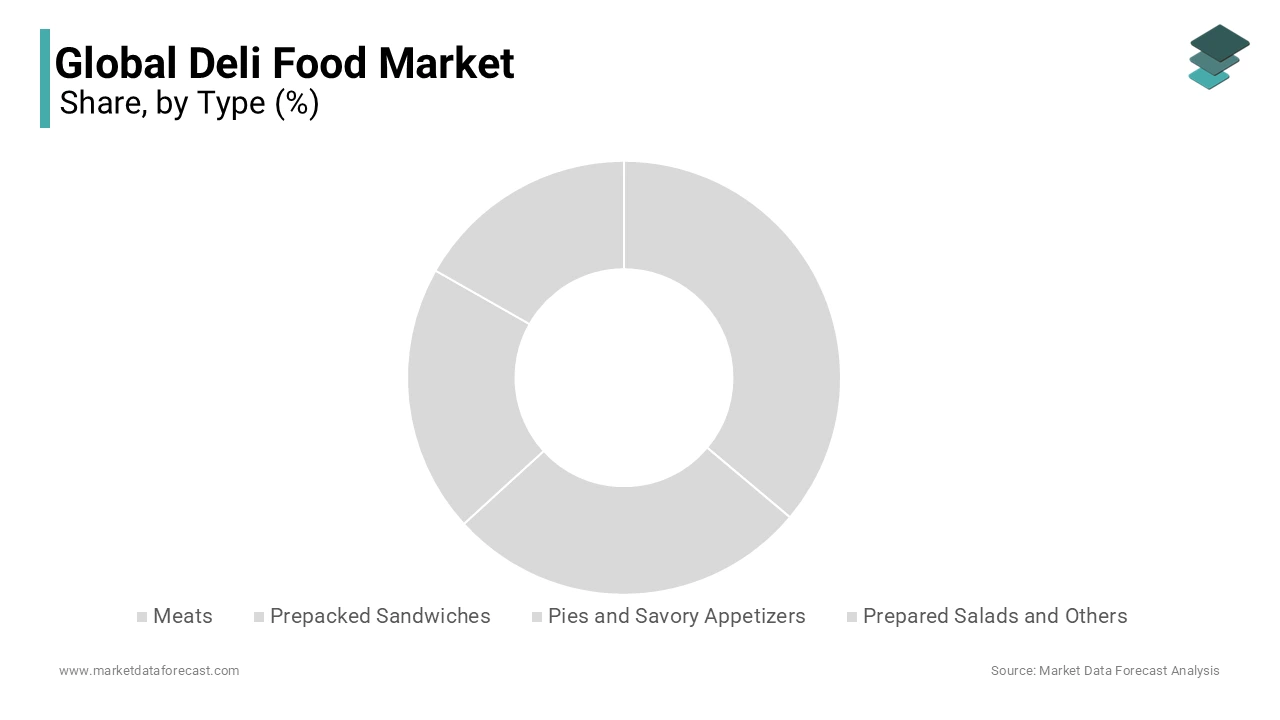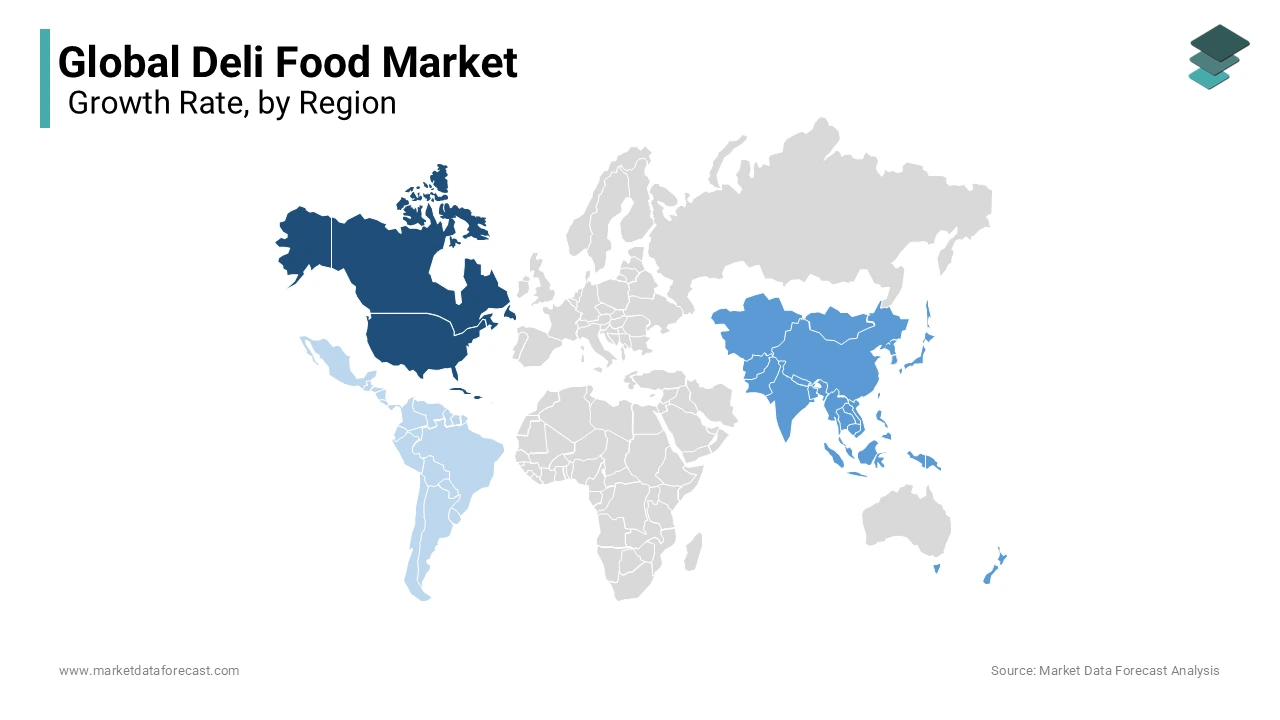Global Deli Food Market Size, Share, Trends, & Growth Forecast Report - Segmented By Type (Meats, Prepacked Sandwiches, Pies And Savory Appetizers, Prepared Salads, And Others), And Region (North America, Europe, APAC, Latin America, Middle East And Africa) – Industry Analysis (2025 To 2033)
Global Deli Food Market Size
The size of the global deli food market was valued at USD 332.56 billion in 2024. The global market is expected to grow at a CAGR of 4.40% from 2025 to 2033 and be worth USD 489.97 billion by 2033 from USD 347.19 billion in 2025.

Prepared foods exemplify a number of foods that are ready to eat, easy to consume, and can be stored for a long time in a freezer or refrigerator for future use. Consumption of these foods, which include a variety of salads, prepackaged sandwiches, pastries, and savory snacks, soups, and meats, has been shown to increase significantly worldwide in recent years. Deli food products are ready-to-eat products that can be easily consumed and stored at low temperatures. Deli foods have become an essential part of lifestyle demographics as the use of preserved foods increases in everyday life. An example of deli food is a set of foods that are easy to consume and can be stored for a long time in the refrigerator for future use. These foods include soup, meat, pastries, prepared salads, prepackaged sandwiches, and savory snacks. Deli food is mainly time-free and consumed by working people. Deli foods have become an important part of the lifestyle of crucial demographic groups due to increased convenience and disposable income.
MARKET DRIVERS
The growth of the deli food market is majorly driven by the increased number of large retail chains, including supermarkets and hypermarkets.
Consumer interest in refrigeration and deli food products is growing, and consumer interest in gaining knowledge and understanding of various nutritional ingredients is one of the key trends driving the global deli foods market. In many markets, convenience trends are balanced by a desire to 'reconnect' with the food consumed, from understanding origins and sources to starting with more dishes. The higher prevalence of health due to the higher prevalence of lifestyle-related diseases affects consumers' and manufacturers' choices of food and ingredients. Changes in global economic, social, and demographic trends can put pressure on food supplies, creating new challenges for food manufacturers and end consumers. These changes are intended to significantly reshape the context of frozen food and consumer perception of categories in the future. As the world population grows and income levels in emerging markets rise, the demand for food and other resources increases to an unprecedented scale, significantly affecting resource availability and market prices.
Given the rapidly changing environment in developing countries like China and India, the demand for raw or frozen meat and dairy products is expected to increase. As more and more people enter the workforce worldwide and adapt to changing lifestyles, retail stores are likely to focus on products that can change the current state of the screen and have a long life. However, the retail sector will likely stand out during the outlook period. Establishing a business unit close to the buyer guarantees a fluid supply of products and maintains the client's participation in the market, along with maintaining quality in freezing conditions. The market is dominated by companies affiliated with local producers and retailers. In emerging markets, market players will have to adopt new strategies as local manufacturers are increasingly using e-commerce portals to sell delicatessen.
The busy lifestyles and consumer preferences for ready-to-eat meals will be one of the key trends that will promote this market growth during the outlook period thanks to the convenience provided. Retailers are trying to keep their meat inventory refrigerated, increasing demand for fast food and ensuring equal availability over the long term. Lifestyle changes, rapid urbanization, GDP growth, rise in disposable income, and growing middle-class populations in emerging economies such as India and China are presumed to fuel growth in this segment during the projection period. Despite significant growth opportunities, some nutritionists are struggling because prepackaged sandwiches are considered unhealthy due to their high salt and sugar content and the use of genetically modified sweeteners.
MARKET RESTRAINTS
Industry participants, especially largely unorganized in Asian countries, face significant problems with the price and quality of their products compared to large multinational companies. Considering the transportation and storage of cryogenic products, high maintenance, and logistics costs are supposed to deter market participants during the prediction period. On the other hand, it is expected that focusing on preventing waste from an environmental perspective will limit this business. In light of high capital expenditures and fluctuations in commodity prices, uncertainty in the cost of delicatessen food production is estimated to affect profit margins. Though the demand for convenience foods is constantly rising across the world, the rising awareness over the use of unsafe ingredients is solely to degrade the growth rate of the deli food market. Food manufacturers rely on using various chemicals to keep the food fresh for a longer time to avoid contamination or spoilage that is processed through various processes in the food industry. By following the stringent rules and regulations imposed by the government, it is highly difficult to manufacture processed food products at reasonable prices, which are negatively impacting the growth rate of the market. However, the quick adoption of the latest technologies in the food industry and the launch of various products using 4G technologies that maintain transparency to the customers promote the growth opportunities of the deli food market.
MARKET OPPORTUNITIES
Millennials and Gen Z people show huge interest in fresh and personalized food products, which are inclined to showcase huge growth opportunities for the market in the future period. Fresh and personalized foods generally focus on the customer’s choice of interest towards their healthy eating habits. The latest innovations in the food industry are propagating to launch various products in favor of customer choices, which is likely to fuel the growth rate of the deli food market. In developed and emerging countries, the demand for deli food is increasing in an unprecedented way. The adoption of ready-to-eat food products is greatly influencing the growth rate of the market. Nowadays, the number of people working is randomly increasing, especially women in emerging countries. Due to the lack of time to cook freshly prepared food, many working-class women prefer to eat ready-to-eat food products like salads, bread, sandwiches, cold-cut meat, and others. Top companies in the food industry are focusing on launching various food products in order to attract customers, especially focused on healthy eating by maintaining transparency in the ingredients used. The shifting trend towards vegetarian-based food products is gearing up to launch new varieties of plant-based foods that are inclined to show new opportunities for the market to grow in the coming years.
MARKET CHALLENGES
Difficulty in adopting new technical developments with the present systems in the food industry is posing a serious challenge for the deli food market key players. Lack of complete knowledge of integrated technology among the staff in the food industry is expected to slow down the huge growth rate of the market during the forecast period. The frequently changing technologies make it highly difficult for the staff to continuously adapt and solve the technical issues that arise in real time. This is attributed to degrading the growth rate of the deli food market. In addition to this, uncertainties in the supply chain of raw materials may also inhibit the production rate of the deli foods which will hamper the market’s growth rate.
REPORT COVERAGE
|
REPORT METRIC |
DETAILS |
|
Market Size Available |
2024 to 2033 |
|
Base Year |
2024 |
|
Forecast Period |
2025 to 2033 |
|
CAGR |
4.4% |
|
Segments Covered |
By Type, And Region |
|
Various Analyses Covered |
Global, Regional & Country Level Analysis, Segment-Level Analysis, DROC; PESTLE Analysis. Porter’s Five Forces Analysis, Competitive Landscape; Analyst Overview of Investment Opportunities |
|
Regions Covered |
North America, Europe, APAC, Latin America, Middle East & Africa |
|
Market Leaders Profiled |
Hormel Foods Corporation, Kraft Foods Group Inc., Samworth Brothers Ltd., Tyson Foods Inc., Waitrose Ltd., JBS S.A., BRF S.A., Astral Foods Ltd., Sisters Food Group, Wm Morrison Supermarkets Plc |
SEGMENTAL ANALYSIS
Global Deli Food Market Analysis By Type

The meats segment is leading with the dominant share of the deli food market. It is a known fact that the demand for meat consumption rate is increasing vigorously. According to the statistics, the consumption of meat across the world will reach 460 million by 2050 due to the growing population. Focus on eating a variety of food products in deli meat products like cold meats, sliced meats, sandwich meats, and others is attributed to accelerating the demand for the meats. Sandwiches can offer varied varieties and can be personalized according to the customer’s choices, where the demand for prepacked sandwiches has increased in the past few years.
Global Deli Food Market Analysis By Dietary Needs
The vegetarian & vegan segment is gaining huge traction over the growth rate of the deli foods market. The shifting number of people towards eating only plant-based food products is greatly influencing the growth rate of this segment. The rising awareness over the protection of the environment by shifting to plant-based derivatives and not harming the animals
Global Deli Food Market Analysis By Distribution Channel
The supermarkets & Hypermarkets segment is leading with the dominant share of the deli foods market. Supermarkets & hypermarkets have long supply chains of deli foods, which is surging the growth rate of the market. In urban cities, there are huge numbers of supermarkets where people completely rely on purchasing convenient food items, which is strongly prompting the growth rate of the market. Specialty deli shops are attributed to have a slow growth rate during the forecast period.
REGIONAL ANALYSIS
North America is leading with the dominant growth rate of the deli foods market. Deli foods are one of the most common products in the North American region as people show much interest in many varieties of foods that can be made in very little time. The growing prominence of introducing high-quality food products according to government regulations is thriving to showcase huge growth opportunities for the deli foods market in North America. The US and Canada are the major countries contributing the highest share of the market. In America, there are more than 204 deli restaurants that provide various food varieties using deli foods, which attract many consumers.
Asia Pacific stands second in holding the prominent share of the deli foods market. The rapid adoption of foreign cuisines in emerging countries like India and China is attributed to boosting the growth rate of the deli foods market. India is stepping into launching various innovative packaging techniques to process high-quality food products for consumers, which is likely to leverage the growth rate of the Indian deli foods market. The launch of locally sourced and organic food products that match the popularity of deli foods is gearing to have huge growth opportunities for the market in the coming years.
Europe's deli food market is expected to hit the highest growth rate during the forecast period 2024-2029. The presence of the top companies that produce a fine array of cold meats to meet the growing demand from consumers in European countries is majorly accelerating the growth rate of the deli foods market. Also, high per capita income and growing investments in the food industry from both the public and private sectors are greatly influencing the growth rate of the deli food market in Europe.
Latin America's deli foods market growth is expected to grow steadily during the forecast period, whereas, in the Middle East & Africa, the growth rate of the market is deemed to have steady opportunities in the future period. Growing expenditure on various food products like meat, sandwiches, salads, and others is particularly to prompt the market growth in the Middle East & Africa.
KEY PLAYERS IN THE GLOBAL DELI FOOD MARKET
Hormel Foods Corporation, Kraft Foods Group Inc., Samworth Brothers Ltd., Tyson Foods Inc., Waitrose Ltd., JBS S.A., BRF S.A., Astral Foods Ltd., Sisters Food Group and Wm Morrison Supermarkets Plc are some of the leading companies in the global deli food market.
RECENT HAPPENINGS IN THE MARKET
- In 2023, Hormel Foods Corporation, one of the deli meats brands, was ready to acquire the Chicago-based food and beverage industry Columbus Manufacturing Inc., with a whopping amount of USD 850 Million. Columbus delivers premium deli meats and Salami, and this acquisition is all set to expand the portfolio of Hormel’s brand in the deli.
DETAILED SEGMENTATION OF THE GLOBAL DELI FOOD MARKET INCLUDED IN THIS REPORT
This research report on the global deli food market has been segmented and sub-segmented based on type, & region.
By Type
- Meats
- Prepacked Sandwiches
- Pies and Savory Appetizers
- Prepared Salads and Others
By Region
- North America
- Europe
- Asia Pacific
- Latin America
- Middle East and Africa
Frequently Asked Questions
1. What are the current trends in deli food markets?
Deli food markets are seeing a rise in demand for healthier options, including organic and locally sourced ingredients. There's also a growing interest in international flavors and fusion cuisines.
2. What are the challenges faced by deli food markets in terms of growth?
Some challenges include rising food costs, competition from other food sectors, and the need to innovate to meet constantly changing consumer preferences. Maintaining consistent quality while scaling operations can also be a challenge.
3. How can deli food markets leverage data analytics for growth?
Data analytics can provide valuable insights into customer buying patterns, market trends, and operational efficiency. Deli food markets can use this data to optimize inventory management, target marketing campaigns, and make data-driven decisions to fuel growth.
Related Reports
Access the study in MULTIPLE FORMATS
Purchase options starting from $ 2500
Didn’t find what you’re looking for?
TALK TO OUR ANALYST TEAM
Need something within your budget?
NO WORRIES! WE GOT YOU COVERED!
Call us on: +1 888 702 9696 (U.S Toll Free)
Write to us: [email protected]
